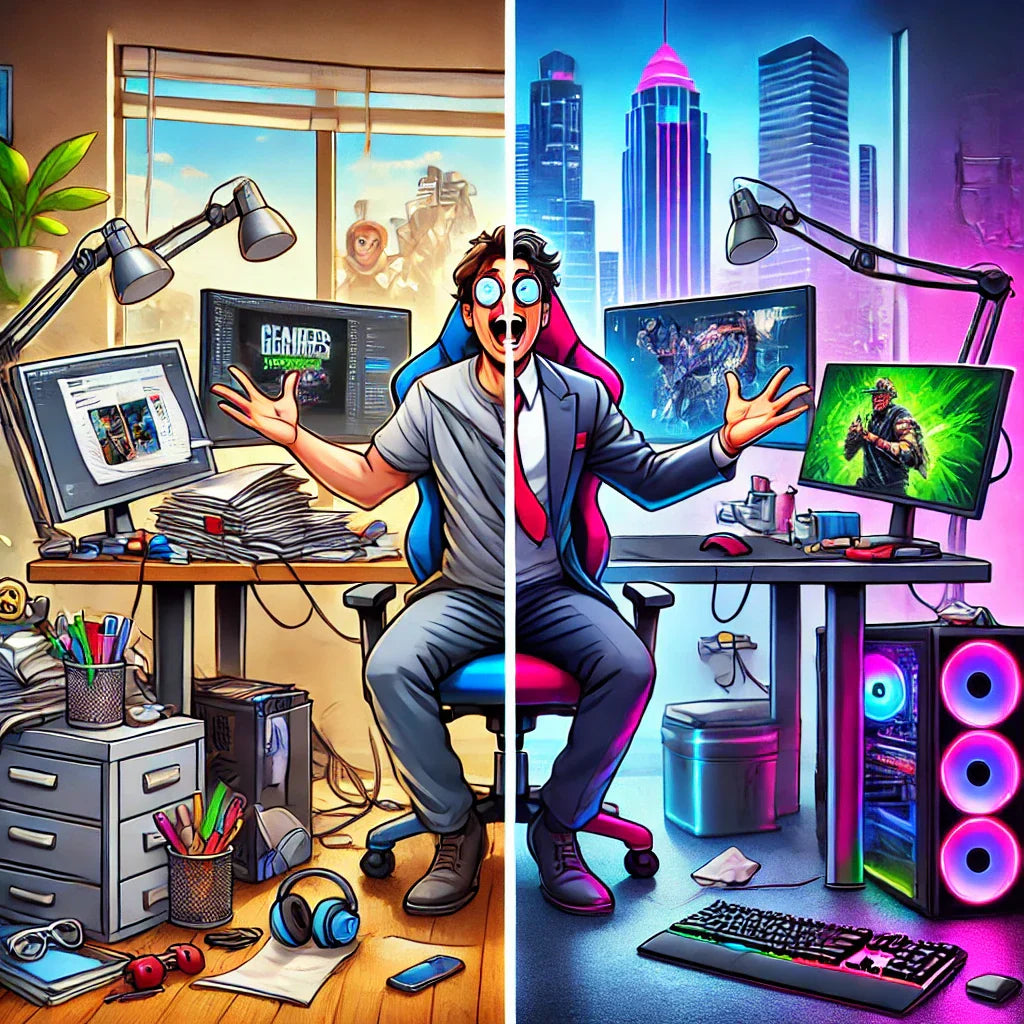
The Influence of the Gaming World on the Modern Design of Productive Workspaces in 2025
Compartir
How the Gamer World Revolutionized Office and Remote Workspace Design
In an era where productivity and well-being are intertwined like never before, gamers have emerged as true pioneers of ergonomic workspace design. What began as a quest for comfort during long gaming sessions has evolved into sophisticated setups that today redefine the way professionals and companies around the world conceive their work environments.
To see how gamer setups influence the configuration of productive workspaces, just take a look at your favorite social network and search for terms like "gamer setup" either "Productivity setup." You'll be surprised to see the similarities: adjustable desks, ergonomic chairs with lumbar support, multiple screens, and ambient lighting, all arranged to maximize comfort and efficiency. It's clear how the strategies gamers use to optimize their gaming environments have also been adopted in workspaces, demonstrating a clear connection between the two worlds that goes beyond the aesthetic.
The Origin: Gamers and the Quest for Extreme Comfort
To understand the influence of gamers on modern ergonomics, it's essential to go back to their roots. These elite gamers, faced with the need to spend 8 to 18 hours in continuous sessions, began to require setups that not only allowed them to be comfortable, but also optimized their performance at the highest level. From the early years, they realized that an ergonomic chair wasn't enough. The ecosystem needed to be broader, encompassing the entire space and every accessory in it. Height-adjustable desks, monitor arms, monitor lights to minimize eye fatigue, foot mats, custom mechanical keyboards, and ambient lighting setups became key elements for an environment where each element adds micro-thousandths of a percent of productivity and focus. These solutions, which initially responded to gamers' needs for concentration and rapid reaction time, now set the standard in offices around the world.

The COVID-19 pandemic accelerated the mass adoption of remote work, and with it, the need for functional and comfortable workspaces. This is where the influence of gamers became crucial. Many professionals, with no prior experience creating efficient setups at home, turned to the accumulated experience of gamers. This group had already perfected the configurations necessary to maximize concentration and efficiency in small spaces, where every element was strategically designed to minimize distractions. What was seen was a migration of the gaming setup to the home office. Desks that adjust to different heights, allowing alternating between sitting and standing, became essential pieces, while monitor arms, adapted for multiple screens, allowed professionals to replicate the immersive experience that gamers already knew.
Psychological Effects: How Design Affects Mental State and Performance
A work environment isn't just a combination of furniture and accessories; it's an extension of one's state of mind. Gamers, who rely on extreme concentration to perform at their best, have been able to demonstrate that a well-designed space can make the difference between productivity and constant distraction. Recent studies show that the configuration of these spaces not only affects physical posture but also directly influences focus and motivation. The customization of these setups, something gamers have turned into an art, allows each individual to adjust their environment to their specific needs, which in turn reduces fatigue and improves performance. For example, monitor backlights and ambient lighting settings, calibrated to prevent eye strain, have become essential elements in professional setups, replicating the gaming logic of a highly focused environment.
While traditional productivity methodologies focus on time management, the gaming world has shown that spatial organization is just as fundamental. In traditional offices, the environment configuration was often static, with fixed desks and limited customization options. However, the flexibility of the gaming setup, where everything adjusts and adapts, offers an innovative alternative that maximizes comfort and efficiency in any space, from a home studio to a shared office. When comparing these methods, it's clear that gamer-inspired setups not only offer ergonomic solutions but also a holistic approach. The combination of elements such as adjustable desks, which encourage movement and prevent aches and pains associated with long hours of sedentary work, and monitor arms, which ensure proper posture and an optimized viewing experience, have transformed the way we understand productivity.
The Total Space: An Ecosystem for Success
Gamers haven't just perfected the ergonomic chair; they've conceived an entire ecosystem. An optimized environment that includes desks that adjust to the ideal height, lights that prevent eye fatigue, and mats that distribute pressure while standing. Even keyboards and mice are designed to maximize precision and minimize muscle tension. These elements, combined, create a space where micro-distractions are eliminated and every second counts to boost productivity. The implementation of these solutions in post-pandemic work environments demonstrates that a holistic approach is key. It's not just a single element; it's the integration of an entire system designed to maximize well-being and performance. Setups that were once considered exclusive to the gaming world are now presented as the new standard for the offices of the future.

References
Haworth's Guide on Ergonomics for Gaming
This article by Haworth describes how ergonomic principles, originally designed to improve gamer performance, are now being applied in office environments to improve concentration, reduce fatigue, and increase productivity. It highlights the importance of elements such as adjustable chairs, ergonomic desks, and strategic monitor placement to prevent common ailments related to prolonged screen time. You can read more at:
https://www.haworth.com/eu/en/spark/articles/2022/q4/10-18_ergonomics-for-gaming.html
Vantage Fit's Workplace Ergonomics Report
This report explains how workplace ergonomics not only improves physical health by reducing the risk of musculoskeletal disorders, but also positively impacts mental clarity and overall productivity. Studies suggest that implementing flexible workstations, adequate lighting, and active breaks are key to maintaining efficiency and well-being in work environments. Further details are available at: https://www.vantagefit.io
If you liked it, feel free to share it and join our blog. Thank you very much!
